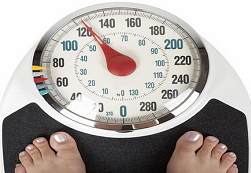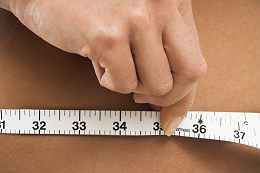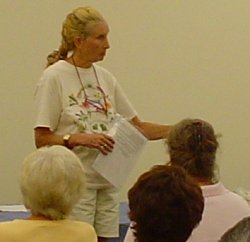Natural Weight Loss and Weight Gain
(Part 5 - Healthy Diet Tips and Recipes)
During our lives, there are times of great physical change, during which we often find ourselves gaining or losing weight. This is considered to be natural weight gain and natural weight loss, as it is expected to occur during certain periods of life.
 About 90% of women gain weight in the months leading up to menopause. Menopause is the time in a woman's life when her periods stop and she is no longer able to bear children. The weight gained during a woman's menopause will sometimes balance out again once menopause finishes. Sometimes it doesn't and you have to consciously try to lose a little weight.
About 90% of women gain weight in the months leading up to menopause. Menopause is the time in a woman's life when her periods stop and she is no longer able to bear children. The weight gained during a woman's menopause will sometimes balance out again once menopause finishes. Sometimes it doesn't and you have to consciously try to lose a little weight.
Some key moments when weight change occurs
Natural weight gain and weight loss often occurs during puberty and will stabilise again after a few months. Pregnancy is the time of greatest natural weight gain and then after the baby is born, some women will naturally lose those extra pounds. Most though will have to pay some attention to the increased weight and do something to take it off.
Natural weight gain and loss occurs at the times in our lives when we undergo enormous physiological changes. Hormones often play a large role in determining natural weight gain or weight loss.
It is important to realise though the difference between natural weight fluctuations and those that are brought about from bad diets, lack of exercise and build ups of chemicals and toxins in our bodies.
Emotions Affect our Weight
 Emotional stress can cause changes in our weight also. Sometimes stress causes a loss of weight, but for many, this can mean putting on the pounds instead. Many of us actually resort to some comfort eating in our lives as it can help us feel better for short periods. The danger though is that this can put in place bad habits which are often hard to change.
Emotional stress can cause changes in our weight also. Sometimes stress causes a loss of weight, but for many, this can mean putting on the pounds instead. Many of us actually resort to some comfort eating in our lives as it can help us feel better for short periods. The danger though is that this can put in place bad habits which are often hard to change.
Many of us respond to life's experiences with weight gain or loss. For example, during periods of grief and turmoil, relationship upsets or break-ups, moving house, changes in jobs, these are all times of emotional change and often stressful and can result in weight loss or weight gain.
Keep yourself motivated - you CAN do it!!!
 It is possible to have fun while you detox and lose weight. Turn the challenge of losing a few pounds to your advantage. One of the key reasons people don’t lose weight consistently is that they give up or lack motivation. This is something you have to work on constantly. It is down to you at the end of the day. You CAN do it.
It is possible to have fun while you detox and lose weight. Turn the challenge of losing a few pounds to your advantage. One of the key reasons people don’t lose weight consistently is that they give up or lack motivation. This is something you have to work on constantly. It is down to you at the end of the day. You CAN do it.
Don't get discouraged or downhearted if your progress slows. Often this is your body reaching a temporary plateau and if you consistently apply yourself to the task at hand, you will eventually bust though any barrier and continue to make progress.
(It is often a good idea to see a health professional if you have any concerns about starting any health program, diet, detox or weight loss plan.)
Twelve Useful Weight Loss tips!
1. Lemon Juice and Hot Water & Herbal Teas
Reduce your milk and caffeine intake, while at the same time, increase your metabolism. Lemon juice in some warm water aids the digestion of fats and other nutrients. Add a little honey to taste if you prefer.
Try drinking some herbal teas instead of the usual tea or coffee. They make a refreshing substitute as well as being caffeine-free.
2. Main Meal at Lunchtime
Try eating your main meal at lunchtime several times a week. On these days, have just a light meal before bed. This way your stomach does not have to work so hard at night. By eating the main meal at lunch you get hours to burn energy before you sleep.
3. Drink Plenty of Fresh Water
Drink plenty of fresh water during the day. Try to drink between 6-8 glasses and a minimum of at least 4. Ideally you should filter the water if possible.
4. Take Regular, Gentle, Daily Exercise
Take a 20 minute walk at lunchtime or before or after work. Look around and enjoy it. Try being creative about the type of exercise you do. There are plenty of options such as swimming, tennis, walking, canoeing, cycling etc.. You can make exercise fun and not a chore!
5. Use Vegetable Oil in place of Butter
Use low-fat vegetable oil, such as olive oil, sesame seed oil or many others, in place of butter. Butter has high saturated fat content, while there are many low-fat vegetable alternatives. However, we don’t recommend most margarines.
6. Drink Skimmed or Low Fat Milk or a Vegetable Milk
If you enjoy drinking milk and have lots of hot chocolates and night caps, then try drinking fat free milk. Soy, rice or oat milks make great, tasty alternatives. Vary the milk you drink, try not to only drink cow's milk, but, if you do drink cow's milk, keep it skimmed or semi-skimmed so you get the nutrients without the fat! If you have tried soy milk and don’t like the taste, then try rice milk. It is very nice, especially with wholemeal breakfast cereals or porridge etc.
7. Substitute Yellow Cheese for White Cheese
Try eating only low fat cottage cheese, low fat ricotta or low fat cream cheese. White soft cheese makes a BIG difference in reducing calories compared to the normal full fat cheeses.
If you simply stopped eating hard, yellow cheese for 6 weeks, you would see a difference in your weight.
8. Replace processed white grains for whole grains
Whole grain cereals will give you a longer lasting energy supply. Porridge made from whole oats is a great breakfast cereal. Try eating a healthy muesli with whole grains and nuts and dried fruits. (Just make sure there is no added sugar). Adding a low-fat, live yoghurt to your cereals and adding some chopped up fresh fruit will give you plenty of probiotics, protein as well as vitamins and minerals.
Cut out foods made from white processed flour. Use wholemeal varieties. This applies to breads, rice, pasta and biscuits etc. Brown, whole grain flour gives you longer lasting energy for a longer period of time.Try eating rice pasta instead of wheat pasta and eating rice cakes instead of wheat savoury biscuits.
9. Use Nutritious Natural Sweeteners instead of Sugar
Maple syrup, honey and black strap molasses are nutritious sweeteners with lower G.I. than white processed sugar. White sugar suddenly increases blood sugar levels and artificial sweeteners are no better and are best avoided in place of honey, molasses or maple syrup.
Black strap molasses is full of minerals - iron, magnesium, copper, zinc and others and nutrients as well as tasting sweet.
10. Increase low-fat proteins, decrease carbs
Low-fat proteins include: tuna, red salmon, low fat cottage cheese, low fat yoghurts (not the sugary ones!), vegetable proteins such as tofu, veggie burgers, chicken, white fish and many more!
Even meats such as free range chicken can be eaten a few times each week as they are relatively low in fat and provide a good source of protein.
11. Cut Down on Ice-Cream and Cakes
These are some of the yummiest foods BUT also some of the fattiest. If you are a regular ice-cream eater, then removing this from your diet can make a big difference. It is one of the foods with the highest amount of sugar and saturated fat content.
The same goes for cakes, especially ones made from white flour and with lots of added sugar, butter and cream.
12. Snack on Protein not Carbs
It has become too easy to snack on high sugary carbs when one is feeling hungry.
Instead try eating a protein-rich snack. This can fill that hunger hole and gradually increase your blood sugar levels, without resulting in cravings shortly afterwards. Protein rich snacks include almonds, walnuts, low fat cheese, pumpkin seeds, sunflower seeds, raisins, grilled fish, sushi and many others.
Here's Part 6 - Regular Exercise and the importance
of Improving poor circulation

